Stephanie Burkhart's Blog, page 82
March 15, 2011
Styles of Poetry - Part 2

I thought I'd share some more styles of poetry with you today.
KYRIELLE
A Kyrielle is a French form of rythming poetry. It is written in quatrains (a quatrain is a stanza with 4 lines).
Each quatrain contains a repeating line or phrase known as a "refrain."
Each line is 8 syllables.
There are no limits to the quatrains, but the minium is 3.
Rythme pattern is up to the poet.
I Saw Death Today
I saw death today, bold yet dark.
His features were black, icy, stark.
He wore an obsidian cloak.
His blade would cut in a swift stroke.
Death slithered around shadowed tree,
He looked sharp gray on bended knee.
The prey was not far from his coat.
His blade would cut in a swift stroke.
Laughing and giggling were they.
Destiny's time was up today.
The sundial struck it's feared note.
His blade would cut in a swift stroke.
*****
ETHEREE
There are 10 lines in an etheree. As you go up in lines, you go up in syllables. For example:
Line 1 - 1 syllable
Line 2 - 2 syllable
and so on.
Line 10 will have 10 syllables.
You can also reverse the ethree starting with 10 syllables and going down to 1. A double etheree has 2 verses with an inverted syllable count starting after line 10.
Nocturnal Hunter
Dark,
he walks
among black
fields and shadows,
creeping, stalking prey.
Obsidian eye cool,
mercurial to the touch.
Fear all around; heart pumping loud.
Prey jumps, bolts toward hoped freedom close.
Dark pounces, hands cold, firm, kill without mercy.
*****
QUATERN
This is a French form of poetry similiar to the Kyrielle.
There are 16 lines, 4 quatrains.
A refrain is in a different line each quatrain. In the 1st quatrian it is in line 1, in the 2nd quatrain, it is in line 2. in the 3rd quatrain, it is in line 3, in the 4th quatrain, it is in line 4.
There are 8 syllables per line.
It does not follow a set rythme scheme.
Shattered by the light of the Moon
Shattered by the light of the moon,
I dropped to the forest ground.
His words were icy and bitter.
Heartbreak's cold arrow would not come out.
I shivered, stung, pricked by ice,
shattered by the light of the moon.
Once done, my nocturnal lover
walked away, no compassion
splayed upon his face, no cold grace.
My brittle bones ached, my skin quaked,
shattered by the light of the moon.
Rejection, so cooly done rent.
Dark hours past, sunrise's twilight peeks
out over an obsidian cloud.
My doomed heart, beating still, was
shattered by the light of the moon.
Published on March 15, 2011 06:00
March 9, 2011
It's ebook week - 7 - 11 MAR 2011!

Over the past couple of years ebooks and ebook readers have exploded making them well, practically mainstream. I, myself, have a Kindle and love it.
So, today I thought I'd explore the Pros of having an ebook reader. If you can think of a "pro" that I haven't mentioned, please chime in.
An ebook reader is generally the size of the book. It's slim, and easily to carry around. When I'm waiting in line at a doctor's office, or Jiffy Lube, I can just whip it out and read.
Ebooks are generally cheaper than print books.
An ebook reader saves shelf space. Mind you, for my absolute favorite stories, I will have a print copy for the shelf (but to be a favorite you've got to be "high" up there, like JK Rowling, for example). Honestly, it's kind of nice to unclutter my shelves.
They are good for the environment. If most of you are a little more aware of the Earth and recycle, ebooks help to save trees in the broad sense.
It's easy to buy a book. With a Kindle, I just activate my 3G and browse the library until I find a book I want. I can have a book at the touch of my fingertips. If I buy from a publisher online, I get a format that will convert easily through my program, Calibre (Mobipocket is another great converter) and upload it. For Kindles, PDF will load, but it's hard to read so I usually buy epub or html for my Kindle if I'm buying from a publisher.
Most ebook readers allow you adjust font, add notes, and highlights. Some ebook readers will play audio books, like my Kindle. My Kindle even has text to speech so I can listen to the book in the car on my way to work. This is one feature of my ebook reader I enjoy very much.
The e-ink technology is easy on the eyes. It's black lettering on a grey background for the most part. Some ereaders come with a backlight or a light to help read in low light.
Mind you, I like a good print book from time to time. There's nothing like holding a print book in your hand, turning the pages, enjoying the fresh clean scent and cozying up in a corner. But again, I usually reserve print copies for books I find very interesting and are my favorites.
Right now I'm reading "Beloved Captive" by Melanie Atkins on my Kindle. What are you reading?
QUICKIE EBOOK FACTS:
E-BOOKS TURN 40! That's right - it's been forty years since Michael S. Hart created the first "e-book".
One of the first genres to become successful in the e-book field was that of the romance story.
A company called E Ink recently introduced a new display technology, e-ink, which mimics the look of paper better than any other display technology.
Read an E-Book Week was first registered with Chase's Calendar of Events in 2004. Chase's is a day by day directory of special days, weeks and months used by event planners or anyone looking for a reason to celebrate.
Many ebook friendly sites have a lot of deals this week to promote read an ebook. Visit http://www.ebookweek.com
Published on March 09, 2011 07:13
March 8, 2011
Genre Tuesday - Paranormal Writing: The Zodiac in the Sky
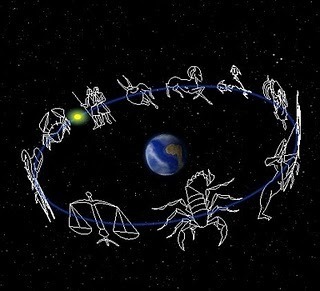
Astrologers have explored the heavens since early Greek and Roman times – as even far back as ancient Babylonia. They gave those constellations that follow the sun's ecliptic a zodiac name to help identify them. But why those constellations? What inspired them? I thought I'd take a look at the myths and legends that are behind the zodiac we see in the sky today.
Ah, the zodiac! We know it well. There are twelve signs, and surprisingly, their basic descriptions seem to fit the type of personality we exhibit.
The night sky is a dark presence in paranormal writing, often times taking on its own personality. After all, vampires come out at night, men transform into werewolves during a full moon, even zombies and ghosts are known to do their haunting at night.
When blending paranormal and romantic elements, looking to the night sky and the dynamic zodiac, can give you, the writer, the inspiration you need.
In my novel, "The Hungarian," my hero, Matthias, is a werewolf who uses the constellations in the night sky to keep him company. He learned the myths behind the zodiac in the stars. I thought I'd share a few of them with you today.
Pisces is well known as representing two fish, but did you know those fish were Venus and Cupid who disguised themselves as fish to escape from Typhon?
Aries has always been represented as a ram. In fact, Aries was a golden ram rescued by Phrixos who took him to the land Colchis.
Taurus is a bull. What I love about Taurus is the stuff you can find in the constellation. Aldebaran is a red giant star that acts as the bull's eye. The Pleiades, a star cluster, can also be found in the bull's shoulder. In myth, Taurus represents Zeus/Jupiter who turned himself into a bull to carry off Europa, the daughter of the king of Crete.
Gemini represents the twin brothers, Castor and Pollux, who helped to protect ships and sailors.
Cancer represents a crab. Juno sent a crab to kill Hercules, who squashed it with his foot. Poor crab! Juno lost out with that idea.
Leo is usually associated with royalty. I believe it has Babylonian roots.
Virgo is usually represented as a maiden. She's the goddess of the farm and harvest and she typically holds a shock of wheat. Again, I believe her origins are Babylonian in nature.
The sun usually find the autumnal equinox in Libria. The constellation is comprised of a set of scales, representing balance. Interestingly, the Romans chopped off Scorpio's claws to make part of Libria.
Juno/Gaia sent the scorpion to kill Orion, who boasted he would kill all the animals on Earth! Poor Juno. She can't catch a break. Scorpio and Orion are on opposite side of the sky, destined to never find each other, but always in search of the other.
Sagittarius is a centaur, a half-man, half-horse archer named Chiron, who is shooting an arrow and comes from Roman myth.
Capricorn is usually represented as a seagoat. Pan used it as a disguise.
Aquarius is a water carrier. Again, this constellation has Babylonian origins.
When you look at the constellations in this light, you have a lot of paranormal romantic potential. Keep in mind the myths that the night sky possess, and see if you can't apply them to your romantic paranormal creatures. You'll add depth to your stories without realizing it.
Published on March 08, 2011 06:36
March 4, 2011
Guest Author Series - Welcome Author Regina Andrews
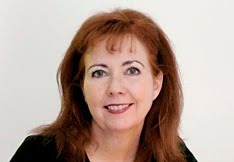
STEPH: Tell us a little about you. Where do you live? How long have you been writing?
REGINA: Hi Stephanie, thank you for having me today on your fabulous blog! A resident of Providence, RI, now, I grew up in nearby Barrington. The Ocean State has a lot of appeal for me!
My wonderful mother read to me as far back as I can remember and I am sure that's why I love reading so much. Loving reading, and being a natural talker, I think writing became the next logical step. It came in handy when I didn't have an audience to tell my stories to, I could just keep going, and write everything down. That began early on, and I just never stopped. The publishing came later.
STEPH: I don't know much about "Light of the Heart." What's it about?
REGINA: "Light of the Heart" deals with the effects of a difficult childhood on the heroine, Cascade Preston, now a very successful stained-glass artist. As a child she knew her father was abusing her mother but was powerless to stop it. She was aware as a child that the town knew of the trouble in her house, yet did nothing to stop it. Her anger and resentment are so intense that she refuses to return to Sterling Lakes. However, circumstances take a turn and the project to redo the stained-glass windows in the town church becomes hers. As she is challenged to let the light of God's love shine into her heart, she also meets the hero, Dan McQuay.
STEPH: What was the inspiration behind the story?
REGINA: That's an interesting question. I have always written pretty 'safe' Inspirationals, and I searched in my heart to hear a story that might needed to be told. Many years ago, I knew the hero and heroine of this story (in my mind) but Cascade's back story only came to me recently. I was not sure about it when I stopped and thought about the theme, it seemed so edgy...so I didn't stop, I just kept writing what was in my heart. After all, I had waited a long time for Cascade to tell me her story! I'm so glad the story incubated and now has the depth and substance her story really deserves. Sometimes, a writer has to be patient, and wait for the story to get to them. I'm not patient, at all! But I am so glad I waited!
STEPH: How important was the setting to the story?
REGINA: Oh, setting is always critical to my stories. Here, it is an absolute 'must'! Sterling Lakes, with all the problems the town has had in the past, and all the natural gifts they enjoy, typifies the dichotomy of the human experience: it's beautiful and ugly, good and evil all at the same time...just like the human soul.
STEPH: If you could cast the movie, who would you cast in the lead roles?
REGINA: OOOH! Okay, Cascade Preston: Amy Adams and Dan McQuay: Let me get back to you, Steph!!
STEPH: How long did it take you to write?
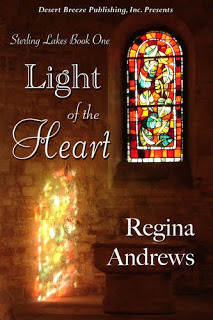 REGINA: Well, it's funny, I really ruminate...and I've been 'hatching' this one since way back when lol! The real work for me is thinking, plotting and envisioning the book. Once I sit down, it does not take too long. This was done in a few months, then delivered to a great editor who I must say really seemed to 'get it' quicker than I did, sometimes! Bless her!
REGINA: Well, it's funny, I really ruminate...and I've been 'hatching' this one since way back when lol! The real work for me is thinking, plotting and envisioning the book. Once I sit down, it does not take too long. This was done in a few months, then delivered to a great editor who I must say really seemed to 'get it' quicker than I did, sometimes! Bless her!STEPH: Do you have an ebook reader? If so, which one?
REGINA: Yes, I have a Kindle that I love love love!!
STEPH Do you belong to any writing groups or writing afflilations? How helpful have they been to you?
REGINA: In the past I belonged to RWA and was in the NE chap of RWA, in fact, I was the librarian for a while. I can't tell you how wonderful that was! What a great group! I am still friends with lots of the writers and count their encouragement as one reason I ever had the confidence to send my work out to publishers!
STEPH: Can you tell us a little about the state you live in?
REGINA: Shakespeare asked "What's in a name?" in Romeo and Juliette and Little Rhody is a good example of a really powerful answer to that query! Rhode Island is the smallest state in the country, but nestled into a section of ocean, mountains and forest, it has incomparable natural beauty. On top of that, we are the nucleus of several world-renowned Universities and Colleges, so our intellectual community is vibrant and ever-evolving. An outgrowth of that is the Arts community, with museums, theaters and -yay - restaurants. Plus, we are a real cultural crossroads, with folks of all nations finding their homes here and propelling the life of the entire community into ever-enriched levels of shared experiences.
STEPH: If you could visit one country, what country would be on your bucket list?
REGINA: In a heartbeat, I'd go back to Greece. I had a trip to Egypt booked for May...I will get there some day!
Thank you, Stephanie!
Big hugs,
Regina
STEPH: Thanks for being here today, Regina! It was great to have you.
Buy Link:http://stores.desertbreezepublishing....
Published on March 04, 2011 06:00
March 3, 2011
California Thursday - Anacapa Island Lighthouse

Anacapa Island Station
Every lighthouse has a story behind it and the Anacapa Island light is no different. Anacapa is an island off the coast of Santa Barbara. It's actually a chain of small island simply called: west island, middle island, east island. They're linked together by a set of reefs that you can see during low tide.
Anacapa's rise to notoriety begins on 2 DEC 1853. A side-wheel steamer called the Winfield Scott was enroute to Panama from San Francisco.
NOTE: Before the Panama Canal was built, ships would leave a west coast city like San Francisco and travel along the coast to Panama. There, they would travel over land, approx. 30 miles, to the east coast of Panama where they would take a second boat, which would then take them to New York City or any other city on the east coast.
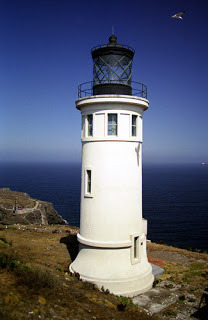 The Winfield Scott carried passengers who had struck it rich from the gold rush. At 11 pm while in dense fog, most of the passengers were sleeping. The steamer struck the middle island. The Winfield Scott was a total loss amid the frenzy to save oneself and their gold.
The Winfield Scott carried passengers who had struck it rich from the gold rush. At 11 pm while in dense fog, most of the passengers were sleeping. The steamer struck the middle island. The Winfield Scott was a total loss amid the frenzy to save oneself and their gold. NOTE: the remains of the Winfield Scott are still submerged just north of the island.
News of the wreck made it to President Franklin Pierce who issued an executive order – Anacapa would be reserved for a lighthouse. It took a while to get there.
In 1874, an unmanned acetylene lens lantern was built on a sketal tower. A whistling buoy was also anchored 5/8 miles off the east end of the island.
Note: In a lens lantern the 2 components are combined into one structure. Lens lanterns have been around for quite a while so there are many different ones which may add to the confusion.
A buoy lamp is a lens-lantern. The glass or transparent plastic part is the lens while the bronze or aluminum or opaque plastic body of the lamp is the lantern. The beautiful 1 and 8 day oil lamps that were hung on poles as minor aids or on pierhead structures, the cut glass and bronze acetylene aids and even the modern plastic lamps are all lens lanterns. Over the years there have been many sizes of lens lanterns.
Like today, tragedy had to happen for action to be instigated. On 28 FEB 1921, the steamer, Liebre, grounded on Anacapa just under the unmanned lighthouse sustaining damages up to $40,000. As before, it was very foggy, but inspectors noted the buoy had overturned and wasn't functioning.
The Anacapa lighthouse station began construction in the spring on 1930. Four houses were built and the light received a 3rd order Fresnel light. A 39 foot tower and a fog signal were constructed near the highest part of the island.
Note: A Fresnel lens design allows the construction of lenses of large aperture and short focal length without the mass and volume of material that would be required by a lens of conventional design. Compared to conventional bulky lenses, the Fresnel lens is much thinner, larger, and flatter, and captures more oblique light from a light source, thus allowing lighthouses to be visible over much greater distances.
In 1962 or poss 1968, (the information is in conflict) the coast guard converted the lighthouse to an unattended station again. The reason? Because missiles were test fired off Point Mugu. The island residents had to spend several hours each week in a shelter.
Today, you can still visit Anacapa and see the lighthouse as well as some of the original building from the 1930's. The lighthouse still aids in navigation.
Published on March 03, 2011 07:49
March 1, 2011
Genre Tuesday - A Look at Romantic Suspense
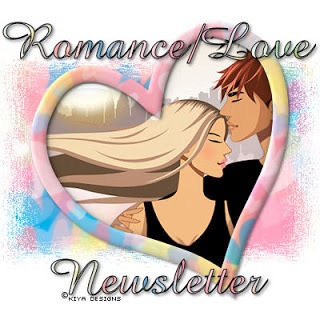
A look at Romantic Suspense
Romantic suspense is a very popular sub-genre of romance. It is also used to transition from romance to more mainstream genres. In order to have a good, solid, romantic suspense, the story must blend suspense and romance in equal proportions and do two things in equal proportions – 1) solve the mystery/suspense 2) have the hero/heroine fall in love.
The Nature of Suspense
What does suspense bring to the table, you ask? It gives the story instant attention. Something dire has happened. Solving the dilemma is a must for our hero/heroine. Keep in mind with suspense that the hero/heroine finds out early on in the story who the villain is. Just how much damage will the villain do before he/she is stopped is the heart of the suspense. Suspense is different from mystery in that in a mystery the hero/heroine take the entire story to find out "whodunit." In suspense, it's a matter of stopping the villain. Remember to use the setting to help create an element of suspense. Weather, also, can heighten suspense.
The Villain
The villain isn't just plain nuts anymore. Readers are more savvy these days and can appreciate a complex villain. Don't be afraid to show the villain's motivation, which can include: ambition, blackmail, thrill, fear, jealousy and even self-defense. A good villain heightens the suspense.
The Nature of Romance
The nature of romantic suspense really necessitates a short time line. You don't have weeks or months to allow feelings to grow – you have days if that, so the chemistry between the hero/heroine needs to be immediate. Don't forget your internal conflict and those niggly little issues in the back of the hero/heroine's mind that makes them hesitant to jump into romance. Just remember you won't have a lot of time for long narratives or character introspection. Phobias work well, too. Think of what scares your hero/heroine and put them in that situation.
The End
Your end has to accomplish two things –the villain is brought to justice and the hero/heroine commit to working things out. Remember a "high" commitment of marriage might seem out of place since the story takes place in a short period of time, but knowing the couple is on the right track will work for the reader.
Published on March 01, 2011 07:10
February 25, 2011
Welcome Guest Author, AR Norris

Living in the Future…Beyond the Techie Monologue
By A.R. Norris
One of my biggest gripes about SF is the techie monologue. You know the one. The characters are going about their adventure and BAM! the narrator cuts into a 3-paragraph lesson -- if we're lucky -- on the detailed mechanism of the lift devise, weapon, or communication system from the character's POV. Ugh already! Yes, we know they're in the future. Yes we know they have cool gadgets. And, yes, they get around in awesome ways.
But how often in your everyday do you think about your surroundings? Do you pause in writing your grocery list to think about the mechanisms of that pen or the adhesive technology of the post-it you're using your pen to write on? No. Do you think about the engineering and materials of the highways (other than cursing about the road conditions)? Probably not. Do you stop and figure out exactly how the magical computer machine is processing and transferring your important information (or like me, the joke of the day)? No.
Why?
Because we're human beings and we take these things for granted. As a reader, I like to see the characters take their futuristic gizmo's and lifestyle for granted too…that way I can be jealous without being irritated or put to sleep at the same time. I don't care the intricacies of the hyper drive system…I just want to visualize the sound and back pressing speed it makes the character hear and feel when it goes vroom. I don't want to know how the alien's DNA differs on the minute scale…just describe the wings, slimy skin, and/or multiple eyeballs and how the character reacts or doesn't react to this appearance.
I'm telling you, for me, it adds a depth of realism to the story. By describing the intricate science behind the world, the writer is wasting word count proving our need to dispend belief. All they really had to do is show how natural the characters acclimated and don't think about the technology to show the natural validity of belief in the world.
I guess my main point, if I were to put it in a one-liner, is: The more humans don't think about the details behind the aspects, the more realistic and valid the aspects are in the story. (For me)
What are your thoughts on this? Are there limits to this for you…no matter how comfortable the characters might be?
Author Bio:
A published author of speculative and science fiction, I live in Napa Valley and am married to a wonderful husband. We have 4 children ranging from 3 to 15 and two canine babies. One very evil cat -- of which the dogs fear -- decided to accept our offer of residency and has tolerated us for about 7 years now.
More Information:
Adventures of a Sci-Fi Writer http://sci-fiadventures.blogspot.com/
Email Contact AmberNorris2000@yahoo.com
Published on February 25, 2011 13:09
February 18, 2011
News From The Publishing World - 18 FEB 2011

Most of my information is taken from the Publisher's Weekly Online edition.
http://www.publishersweekly.com
It's been an interesting week in the publishing industry to say the least.
Here a couple of items and my commentary.
1. EBooks continue to do outstanding in today's market. Sales figures reported in 2010 estimate that ebook sales jumped to 164.4% totaling $441.3 million. These figures were reported by 14 publishers who report to the Association of American Publishers. Knowing there are a lot more than 14 publishers out there, I have no doubt the numbers are higher.
Steph's thoughts: ebooks continue to grow in popularity. Ereaders do for books what Mp3s and ITunes have done for music. I see sales steadily continuing to increase.
Question: Is the digital transition to ereaders a cause of economic uncertainty for authors?
Steph's thoughts: I'd love to hear your thoughts on this. Bestselling author Margaret Atwood recently addressed a tech-orientated publishing talk and seemed to believe it was. For me, just knowing how much ebook sales have risen, I would say no, at least from an economic point of view. As far as the traditional publishing model, and the big traditional publishers, there is more room for uncertainty, especially since so much goes into producing, printing, and marketing of print books.
Food for thought: What's the best way to sell an ebook?
2. So what makes this week interesting? The news that major book seller, Borders, has filed for bankruptcy. The bankruptcy will allow Borders to restructure into a leaner book seller. Out of 642 stores in the USA, 200 will close.
What does that mean for authors? For Readers? What did Borders do wrong? Were they too late switching to the ereader Kobo? I'd love to hear your thoughts about Borders and the publishing world this week.
Smiles
Steph
Published on February 18, 2011 12:30
February 14, 2011
Happy Valentine Day - enjoy Elmer's Valentine
Hi all, since it's excerpt Monday I thought I share my little children's story, Elmer's Valentine. It's 545 words and I wrote for my Little Children's class. We did it yesterday for them and they loved it. We had the kids hold up flowers so they could be the flower garden.
Enjoy,
Steph
and PS - Have a great Valentines Day!
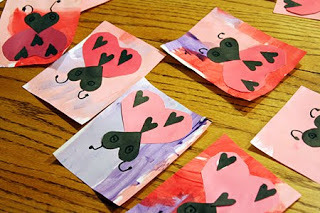
Elmer the Gentlemanbug blew into the garden one day on a breeze. He was called a Gentleman bug because that's what all boy ladybugs were called.
The garden was a busy place. A young girl named Addison pulled the weeds. When she wasn't there, though, there were lots of other bugs to help out.
A family of bees lived near the roses. A family of butterflies made their homes in the daffodils. A little frog hopped through the garden on his way to the pond every day. A family of worms helped to keep the dirt nice and fresh.
Elmer made his home next to the marigolds. He made a small house of sticks and twigs. He had a leaf to sleep on at night and flowers gave him shade when the sun was shining.
One day on his way to visit the violets, Elmer came across a ladybug.
"Hello, my name is Elmer," he said.
"My name is Elena."
"Do you live here?" asked Elmer.
"I live with my parents next to the lilies. I haven't seen you before. Where are you going?"
"I'm on my way to help the bees scatter the pollen dust on the daisies today. Where are you going?" asked Elmer.
"I'm going to look for some grapes."
"I have to get going, It was nice meeting you, Elena."
"Good bye, Elmer."
Every day for a week, Elmer met Elena near the violets. They said hello and talked about what they were going to do that day. Elmer decided he liked Elena very much.
One day, Elmer met Elena by the violets, but it was very windy out. Elmer could barely fly.
"Hello, Elena."
"Hello, Elmer. Be careful today. Daddy says a storm is blowing in."
Elmer flapped his wings. "I will. You, too."
The wind blew harder. Raindrops fell from the sky. Elmer rushed back home and snuggled against the marigolds in his house.
It rained for a very long time. Elmer was a little scared and worried for Elena. He hoped she was okay.
The next day the sun came out. Elmer peeked out of his house. The dirt was wet and the flowers were damp, but all the flowers were okay.
Elmer realized he missed Elena. He cared for his friend very much. Elmer decided to write a Valentine for Elena to tell her how much he valued her friendship. Elmer visited the worms who were busy swimming in a small rain puddle.
"Hello, Worms. Do you have any paper?"
"I saw a bubble gum wrapper near the lilies," said one worm.
"I think the rain washed it in," said another worm.
"Thank you," said Elmer. He buzzed to the lilies and found the wrapper. He wrote: "Elena, I'm glad you're my friend. Be my Valentine, Your friend, Elmer."
When he finished, he flew off to find his friend.
Elena was helping the bees dry off the roses by flapping their wings. Elmer flew up to Elena.
"I was worried about you," said Elmer.
"I was worried about you, too," said Elena.
Elmer handed Elena his valentine. She read it and smiled.
"Thank you, Elmer. It's very pretty. I'm glad you're my friend."
Elmer smiled. He was glad they were friends, too.
Enjoy,
Steph
and PS - Have a great Valentines Day!

Elmer the Gentlemanbug blew into the garden one day on a breeze. He was called a Gentleman bug because that's what all boy ladybugs were called.
The garden was a busy place. A young girl named Addison pulled the weeds. When she wasn't there, though, there were lots of other bugs to help out.
A family of bees lived near the roses. A family of butterflies made their homes in the daffodils. A little frog hopped through the garden on his way to the pond every day. A family of worms helped to keep the dirt nice and fresh.
Elmer made his home next to the marigolds. He made a small house of sticks and twigs. He had a leaf to sleep on at night and flowers gave him shade when the sun was shining.
One day on his way to visit the violets, Elmer came across a ladybug.
"Hello, my name is Elmer," he said.
"My name is Elena."
"Do you live here?" asked Elmer.
"I live with my parents next to the lilies. I haven't seen you before. Where are you going?"
"I'm on my way to help the bees scatter the pollen dust on the daisies today. Where are you going?" asked Elmer.
"I'm going to look for some grapes."
"I have to get going, It was nice meeting you, Elena."
"Good bye, Elmer."
Every day for a week, Elmer met Elena near the violets. They said hello and talked about what they were going to do that day. Elmer decided he liked Elena very much.
One day, Elmer met Elena by the violets, but it was very windy out. Elmer could barely fly.
"Hello, Elena."
"Hello, Elmer. Be careful today. Daddy says a storm is blowing in."
Elmer flapped his wings. "I will. You, too."
The wind blew harder. Raindrops fell from the sky. Elmer rushed back home and snuggled against the marigolds in his house.
It rained for a very long time. Elmer was a little scared and worried for Elena. He hoped she was okay.
The next day the sun came out. Elmer peeked out of his house. The dirt was wet and the flowers were damp, but all the flowers were okay.
Elmer realized he missed Elena. He cared for his friend very much. Elmer decided to write a Valentine for Elena to tell her how much he valued her friendship. Elmer visited the worms who were busy swimming in a small rain puddle.
"Hello, Worms. Do you have any paper?"
"I saw a bubble gum wrapper near the lilies," said one worm.
"I think the rain washed it in," said another worm.
"Thank you," said Elmer. He buzzed to the lilies and found the wrapper. He wrote: "Elena, I'm glad you're my friend. Be my Valentine, Your friend, Elmer."
When he finished, he flew off to find his friend.
Elena was helping the bees dry off the roses by flapping their wings. Elmer flew up to Elena.
"I was worried about you," said Elmer.
"I was worried about you, too," said Elena.
Elmer handed Elena his valentine. She read it and smiled.
"Thank you, Elmer. It's very pretty. I'm glad you're my friend."
Elmer smiled. He was glad they were friends, too.
Published on February 14, 2011 11:24
February 12, 2011
The Califorina Lighthouse Series - The Santa Cruz Lighthouse
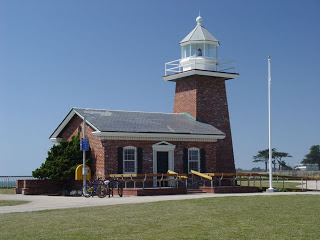
Located on the northern shore of Monterey Bay, the Santa Cruz lighthouse was originally built in 1868.
I've always enjoyed visiting the ocean, and while I've never seen too many lighthouses, I find them fascinating. They capture the ambience of the romance of the seas. Each lighthouse has it's own unique story which I hope to share with you during these series on California Lighthouses.
The Santa Cruz lighthouse has a rich, sentimental history. It was a wooden structure with a tower modeled after the light at Ediz Hook, WA. Originally, the light was white, but soon was changed to red, so it could be distinguished from the various residential lights in the area.
Interestingly only ten years after it was built, the lighthouse faced destruction from erosion. It was moved 300 feet to firmer ground by several horses. The mover was paid $750.00 for the job! (in 1879)
What gives a lighthouse its personality are the people who care for it though. Every lighthouse has a story.
The Santa Cruz lighthouse's first caretaker was Adna Hecox. He moved into the lighthouse with his family in 1870. He provided for his family by growing a garden and keeping chicken. He passed away in 1883 and his daughter, Laura, become the next caretaker.
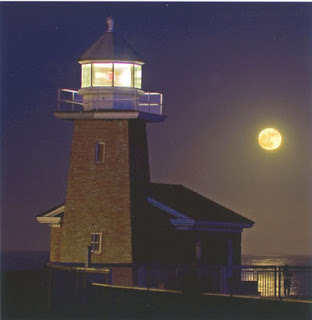
Laura was paralyzed on one side of her body, but she didn't let that slow her down. She became an avid amateur marine biologist, well respected by her peers and professors around the country. She retired in 1916.
Arthur Anderson became the caretaker after Laura. Electricity made his job easier. He retired in November 1940 and in 1941, the Coast Guard assumed responsibility for the light. With World War II, the Coast Guard turned the lighthouse into a lookout and the 54th Coast Artillery Regiment, an all-African-American unit, was assigned to the lighthouse with the mission to protect the coastline.
In 1948, the lighthouse, was dismantled, and it's lumber was used for other projects. In 1965, a family tragedy would give Santa Cruz a new lighthouse.
Mark Abott was 18 and drowned while body surfing off the waters 3 miles east of Santa Cruz, Mark's family, knowing his love for the ocean and lighthouses, built the Mark Abbott Memorial Lighthouse on the land the old lighthouse had stood on.
Since then, the lighthouse has been home to the Santa Cruz surfing museum. Currently the Santa Cruz Surfing Club Preservation Society runs the lighthouse museum. Bits of Laura's collection of shells can still be found today at the Santa Cruz Museum of Natural History.
Do you have a favorite lighthouse you like to visit?
Smiles
Steph
Published on February 12, 2011 06:00



